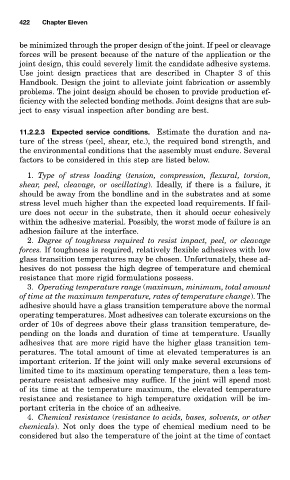Page 486 - Handbook of Adhesives and Sealants
P. 486
422 Chapter Eleven
be minimized through the proper design of the joint. If peel or cleavage
forces will be present because of the nature of the application or the
joint design, this could severely limit the candidate adhesive systems.
Use joint design practices that are described in Chapter 3 of this
Handbook. Design the joint to alleviate joint fabrication or assembly
problems. The joint design should be chosen to provide production ef-
ficiency with the selected bonding methods. Joint designs that are sub-
ject to easy visual inspection after bonding are best.
11.2.2.3 Expected service conditions. Estimate the duration and na-
ture of the stress (peel, shear, etc.), the required bond strength, and
the environmental conditions that the assembly must endure. Several
factors to be considered in this step are listed below.
1. Type of stress loading (tension, compression, flexural, torsion,
shear, peel, cleavage, or oscillating). Ideally, if there is a failure, it
should be away from the bondline and in the substrates and at some
stress level much higher than the expected load requirements. If fail-
ure does not occur in the substrate, then it should occur cohesively
within the adhesive material. Possibly, the worst mode of failure is an
adhesion failure at the interface.
2. Degree of toughness required to resist impact, peel, or cleavage
forces. If toughness is required, relatively flexible adhesives with low
glass transition temperatures may be chosen. Unfortunately, these ad-
hesives do not possess the high degree of temperature and chemical
resistance that more rigid formulations possess.
3. Operating temperature range (maximum, minimum, total amount
of time at the maximum temperature, rates of temperature change). The
adhesive should have a glass transition temperature above the normal
operating temperatures. Most adhesives can tolerate excursions on the
order of 10s of degrees above their glass transition temperature, de-
pending on the loads and duration of time at temperature. Usually
adhesives that are more rigid have the higher glass transition tem-
peratures. The total amount of time at elevated temperatures is an
important criterion. If the joint will only make several excursions of
limited time to its maximum operating temperature, then a less tem-
perature resistant adhesive may suffice. If the joint will spend most
of its time at the temperature maximum, the elevated temperature
resistance and resistance to high temperature oxidation will be im-
portant criteria in the choice of an adhesive.
4. Chemical resistance (resistance to acids, bases, solvents, or other
chemicals). Not only does the type of chemical medium need to be
considered but also the temperature of the joint at the time of contact

